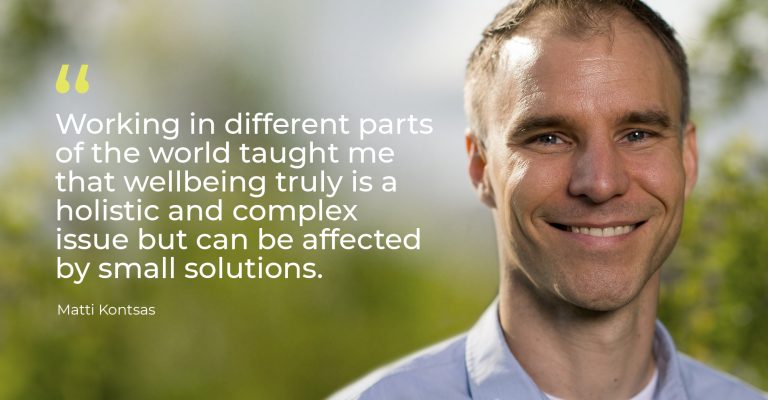How to Use Mental Imagery to Improve Life Control and Decision Making

Humans are paradoxical beings; what we wish to do in our lives is many times far from what we actually end up doing. We are good at failing to make our fancy words and aspirations a reality. I have noticed this in my own personal life as well as in the life of some of the clients I am coaching. How could we all take better control of our decision making so that we could perform better and live better lives? Could mental imagery be part of the solution?
At Hintsa we believe better life and better performance stems from a variety of components summarised in our Circle of Better Life model. At the centre of the model is something we call the Core: your identity, your true goals and your sense of control. Control is a tricky thing. Once you have asked yourself are you in control of your life, you need to dig deeper. What are the internal obstacles that prevent you from really living out your identity and purpose? What could explaing the gap between idealistic intensions and real-life behaviours?
The gap between intention and action
One of my clients enjoyed running and wanted to get more fit, so he decided on a goal to go running twice per week for 30 minutes. He had strong intentions to do the running and valuable reasons behind his intentions. Yet, he managed to do only 2 running sessions in a month, even though he had booked all the running sessions in his calendar. What happened?
We started to examine his behaviour and the reasons behind it. What we found was that work commitments overruled the running most of the times. Yet, he did think that in those specific time slots in his calendar, running was more important than work. So what made him work rather than run?
After some reflections and discussions, he realised that it was the feeling of fear. Fear of not delivering high enough quality for his clients. Fear of not being accepted and appreciated if he would not work hard enough. This fear resulted in him doing more than he deep down wanted to do. Something that wasn’t even required by his clients or colleagues. What he needed to do was to take better control of his life. A challenging endeavour.
Understanding the human mind
I’m sure many of us recognise similar challenges in our lives. What could you do overcome internal obstacles, such as fear? First, you need to know a little about how the human mind works.
Daniel Kahneman and Amos Tversky conducted decades of Nobel price winning work on the human mind and its strengths and limitations, resulting in a 2011 book “Thinking, Fast and Slow“. They conceptualized the modes of the human mind to the fast and automatic “System 1” and the slow and effortful “System 2”. It appears that the fast, emotion laden and intuitive system 1, which is unconscious and works on “autopilot”, is by far more prevalent and influential in our lives compared to the conscious and analytical system 2.
We seem to derive assumptions of reality from our past experiences that may or may not be functional in a given situation. Thus, all of us have many biases which may result in us doing “bad decisions” in our lives. The good news is that we can program our minds and increase our likelihood to do “good decisions”, instead of being in the mercy of the autopilot system, or merely relying on willpower as research has shown they often fail us. One way of programming the mind is mental imaging.
Imagining your way to success – like an athlete
Gabriele Oettingen and her colleagues have researched goal setting and turning positive fantasies into reality. They have developed a 4-step, empirically validated imagery technique to help people identify their goals and more importantly, how to really manifest them in important areas of life. Imagery is a learnable skill, which is honed to a remarkable degree by elite athletes. Also, simulating future possibilities, or prospection seems to be innate to human beings and a cornerstone to how we actually think, as Seligman and his colleagues have argued in their “Homo Prospectus” book.
Are you tapping to this skill as well as you could? For example, an elite racing driver can imagine very vividly (incorporating all senses and emotions) a qualifying lap with an error margin of less than 0.5 seconds. One lap is usually around 1 min and 30 seconds so the margin seems unfathomable for a common person. The driver can even change tyres in his mind and set the imagined time close to what those tyres can do. This highly developed imagery skill allows the driver to simulate the future very accurately, which allows him to be able to react in the most accurate way in the actual qualifying lap. In a way, the driver has done the qualifying round already in his mind so he is calm and prepared to execute in real life.
Furthermore, the better ability the athlete has in using mastery and goal content in the imagery, the more confident (s)he will be, which, in turn, predicts seeing more opportunities in the performance situation (i.e. challenge appraisal) rather than threats. Similarly, we all can develop our ability to simulate the future so we could be best prepared to act in according to what we hold most dear to us in a specific situation that we find challenging to act in a values-consistent manner.
Imagery includes, but is not limited to, visual information. In fact, the integration off all the senses in mental imagery is key to adaptive behaviour in the desired context, as this allows coherent representations of the world. It takes mental work to get more and more vivid mental images and also support from others to correct our subjective errors as there is no shortage of errors and biases in all of us.
4 steps to imagery training
The 4-step practical imagery model by Oettingen and her colleagues, which I mentioned earlier, is nicely summarised in one of our earlier blog posts. Oettingen and her colleagues call this the WOOP method, which helps us all to remember the four steps: wish, outcome, obstacle, plan.
The first step in the process is to identify a wish that is dear to you. In my example client’s case, that wish was to run twice per week for 30 minutes. The second step is to imagine the best possible outcomes of that wish, as vividly as possible – how would it feel once your wish is completed? What is the impact of your fulfilled wish? Next, identify what is it in you that is standing in the way of making your goal a reality? The key is to look inside you and your own behaviour, not so much on external factors, as the only thing you can truly control is yourself. In my client’s case, the main obstacle turned out to be the fear of not doing a good enough job. Finally, you need to put a behavioural plan in place to overcome that obstacle by connecting an IF statement (the obstacle) to THEN statement (my behaviour). For example, if I get the feeling of fear of not doing good enough job, then I will still stop my work in time to go running. Or, if I get the feeling of fear of not being accepted, I will still say no to commitments that override my running plans.
This process of “mind programming” needs conscious effort so that it will become part of your automatic habit system. Also, the wish needs to be feasible (i.e. manageable in practice) as well as challenging (otherwise we wouldn’t need any strategies to do the desired behaviour). Even five minutes of conscious imagery going through the four steps can yield some results. However, it is crucial to give enough time and mental space to deeply focus on this task, as otherwise, the planning phase, i.e. the simulation of the future, may not be accurate enough.
Make your changes sustainable
Download our free WOOP template:
Doing mental imagery needs some practice as all skills do – so remember to be patient and hone your skill so over time you have a greater capacity to take control of your life. After all, an athlete is not good at imagery and subsequent performance because (s)he just is, but because (s)he has trained it extensively. If you have a wish that is dear to you but challenging, you can download our free WOOP template and start training your own skill of imagery!
Interested in hearing more about our coaching services? Leave your contact details below and we’ll be in touch.


